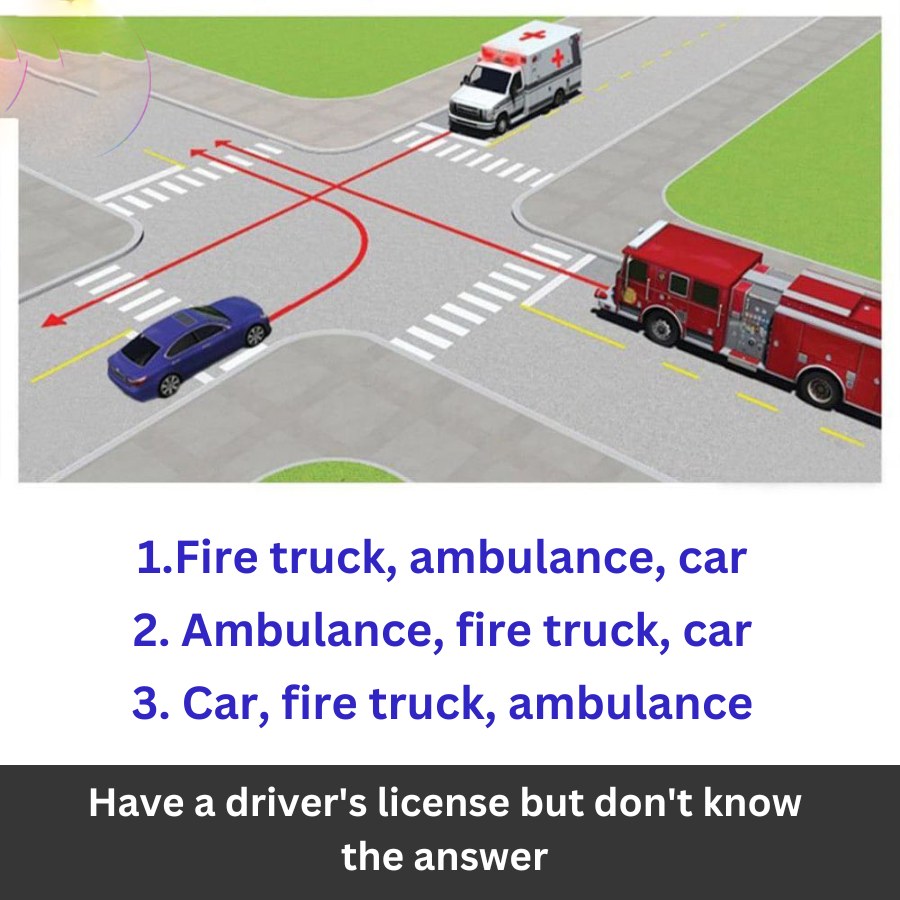A driver’s license is a symbol of independence and responsibility. It grants you the privilege of navigating the roads and following traffic rules designed to ensure everyone’s safety. However, possessing a driver’s license doesn’t always mean knowing all the answers to traffic-related questions, especially ones that seem simple at first glance. Here’s a question that often stumps even experienced drivers:
Which vehicle has priority when a fire truck, an ambulance, and a regular car all approach the same intersection?
The answer is: Fire truck, ambulance, car.

This sequence may seem straightforward to some, but many drivers fail to recall it when faced with real-life situations. Let’s explore why this order exists, why it’s crucial to understand, and how it impacts road safety.
Why Is the Fire Truck First?
Fire trucks hold the highest priority because they often respond to emergencies where every second matters. Fires can escalate rapidly, putting lives, homes, and entire neighborhoods at risk. A delayed response could mean the difference between containing a fire and facing a devastating loss.
Firefighters are equipped with tools to extinguish flames, rescue individuals trapped in dangerous situations, and prevent further destruction. Given the nature of their mission, fire trucks are designed to reach their destinations as quickly as possible, even if it means interrupting regular traffic flow.
Why Does the Ambulance Come Next?
Ambulances also respond to life-or-death situations, transporting critically ill or injured individuals to medical facilities. While equally important, ambulances often have a slightly longer response window compared to fire trucks because medical emergencies are generally contained within a smaller area or involve fewer immediate threats to a large number of people.
That said, when you see an ambulance on the road with its sirens blaring, your swift action to yield can directly impact someone’s chance of survival. Delaying an ambulance, even by a few moments, could have dire consequences for the patient inside.
Why Is the Regular Car Last?
Regular cars come last in the hierarchy because they’re not involved in emergencies. While you might be on your way to work, an appointment, or even an important event, those situations pale in comparison to the urgency faced by fire trucks and ambulances.
Your role as a responsible driver is to yield and make room for these emergency vehicles to pass, ensuring they can perform their duties without interference. This rule not only reflects common sense but also complies with traffic laws across the United States.
Why Do Drivers Get This Wrong?
Despite its simplicity, many drivers either forget or are unaware of this priority order. There are several reasons for this:
- Lack of Regular Reinforcement: Most people learn these rules during driver’s education but rarely revisit them afterward. Without periodic reminders, it’s easy for such knowledge to fade over time.
- Stressful Situations: The presence of sirens and flashing lights can create panic, causing some drivers to hesitate or make incorrect decisions about yielding.
- Regional Differences: While the general principles of yielding to emergency vehicles are consistent, specific traffic laws and practices may vary slightly by state or city. This can add to the confusion for drivers who frequently travel between different areas.
Why Knowing the Answer Matters
Understanding the correct order of priority isn’t just about passing a theoretical test—it’s about real-world impact. Emergency vehicles rely on quick and unimpeded access to roads to save lives and protect property. Any delay caused by confused or hesitant drivers can have far-reaching consequences.
Imagine a fire truck stuck in traffic, unable to reach a burning building in time to prevent it from collapsing. Or think about an ambulance delayed en route to a hospital, putting a critically ill patient’s life at greater risk. These scenarios highlight the importance of every driver knowing and following the rules.
What Should You Do When Emergency Vehicles Approach?
When you hear sirens or see flashing lights, your immediate response should be to safely pull over to the right side of the road and stop. Wait until the emergency vehicle has passed before resuming your journey.
If multiple emergency vehicles are approaching, remember the hierarchy: fire truck first, ambulance second, and regular traffic last. By acting quickly and decisively, you can help ensure these vehicles reach their destinations without delay.
A Reminder for Every Driver
Having a driver’s license is a privilege that comes with significant responsibilities. It’s not enough to know how to operate a vehicle—you must also understand how to share the road with others, including emergency responders.
Regularly refreshing your knowledge of traffic rules and emergency protocols can make you a safer, more confident driver. Take a moment to review your state’s driver’s manual or consider taking an online refresher course. Staying informed helps protect not just you but everyone who shares the road.
The Bottom Line
Driving is more than just a means of getting from point A to point B—it’s a shared responsibility. Knowing the correct order of priority for emergency vehicles—fire truck, ambulance, car—ensures you’re doing your part to keep the roads safe and efficient.
So, the next time you hear a siren, don’t panic. Just remember the simple rule: fire truck, ambulance, car. By yielding appropriately, you’re playing an essential role in saving lives and supporting your community. Safe driving!